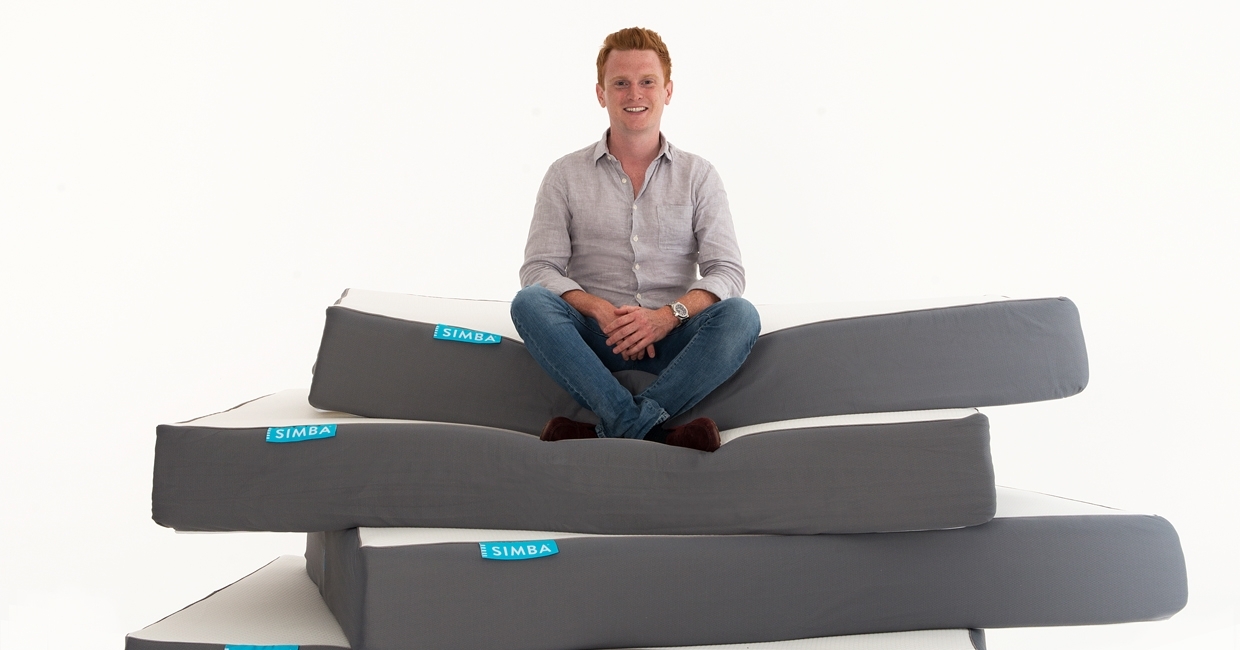From a standing start in 2015 to a global expansion plan that will see it enter a new country every two weeks, London-based mattress brand Simba Sleep is matching the US beat for beat. Furniture News meets the founder of the homegrown bed-in-a-box outfit that just can’t wait to be king …
“The bed market has been monopolised by the big players for too long,” states Simba’s founder and CEO, James Cox. “We want to change that, and improve the way people sleep.”
Established in 2015 and launched months later in February 2016, the British answer to the US bed-in-a-box invasion quickly established itself as a force to be reckoned with, hitting the £10m sales mark in just seven months and racing ahead of rivals Eve and Casper.
In many ways, Simba’s approach mirrors that of its competitors – one product, dynamic marketing, technological and logistical expertise – but James says it’s the unique elements which have made the difference.
“We’ve always wanted to innovate rather than replicate,” he says. “Tuft & Needle were around long before the likes of Casper, but the ability to reach the consumer with such a clear product story has completely changed the market. We strove for consumer satisfaction, but to achieve this and stand out from the crowd required us to really prioritise innovation.”
James co-founded Simba with the help of founder of Tribesports.com, Steve Reid, and the McClements family, which had been selling thread for mattressmaking since 1979 and helped ground the firm in the specifics of the UK mattress industry.
The team assembled to help Simba fund, explore and deliver its concept comprised backers such as Spark Ventures and The Garage Soho, which were joined by angel investors including Tom Teichman (made.com, lastminute.com, notonthehighstreet.com), Nigel Wray (formerly Domino’s, Saracens, Franchise Brands), the founders of Innocent Drinks Richard Reed, Adam Balon and Jon Wright, and the Jatania Family (formerly Lornamead – Vosene, Yardley).
“We went for industry names rather than venture capitalists, and they’ve definitely helped us shape the brand,” says James. “John Hegarty [founder of global creative agency Bartle Bogle Hegarty] and several others have been great on the marketing side of the business, while David Hickson [founder of tech backer Founders Factory] gave us great advice on what not to do.
“All three of Innocent’s founders have helped from a brand and logistical perspective. Innocent have already transformed the market, changing the way fruit is consumed – we saw strong parallels with what we were doing.”
While its competitors’ models exclusively employ foams, Simba’s hybrid throws pocket springs into the mix, more closely reflecting the established preferences of UK consumers. “Springs have become unfashionable in certain territories, but we saw the need for the comfort of foam and the support of springs,” says James. “It brings a bit more life into the mattress.”
“Innocent have already transformed the market, changing the way fruit is consumed – we saw strong parallels with what we were doing”
Simba’s mattress comprises five layers of memory foam, supported by 2500 patented conical pocket springs, which says the company, do not compress in a linear fashion, meaning sleepers of different weights are unlikely to experience roll-together. This additional engineering means that they retail for around £50 more than their competitors’ (“but we never discount”, James clarifies).
Simba’s dynamic marketing machine, which employs a mix of “online and offline marketing to reach the consumer appropriately”, is typical of its breed, but whilst not as prolific as some of its rivals – “go back eight months, and you couldn’t move without seeing Casper’s presence on the London underground” – it places rather more emphasis on product quality.
“We’re the only brand that opens up our mattress to show people what’s inside – making clear what we’re offering, and why it’s better than the rest,” says James.
While a next-day delivery promise – bolstered by a (now-standard) 100-night trial and 10-year guarantee – is undoubtedly a key selling point, product remains at the heart of Simba’s offer, says James. “We don’t sell on the basis that we’re a boxed product,” he says. “We focus on the fact that it’s a great mattress.”
Simba recently commissioned independent research that studied sleepers’ experiences on its mattresses alongside two key rivals, Eve and Casper.
The results were encouraging: Simba mattress sleepers enjoyed an extra 21 minutes of sleep a night than those on the nearest rival (equating to around 16 extra nights’ sleep a year); Simba mattresses recorded the most owners who would buy one again, and none who said they wouldn’t; and 83% of sleepers preferred Simba to their previous mattress, compared to 75% and 67% for its rivals.
Although detractors of the one-type-fits-all offer would argue that consumers prefer more individually-tailored sleeping solutions, James is confident that his answer is suitable for most, having worked with the Sleep to Live Institute to compile data from 10 million people.
“From these huge data sets, we developed a model that’s suitable for more than 95% of the UK population,” says James. “Of course, many people make claims like this, but we deliver – the theoretical limit to our returns rate is 8%, but our average is currently just 4.5%.”
This figure has been significantly suppressed thanks to Simba’s lucrative partnership with John Lewis, a high-profile physical anchor for the online brand through which around 250 mattresses are sold each week. While the company’s direct-to-consumer returns rate is 6.2%, it’s less than 2% from John Lewis’ 45 stores, says James.
“Physical wasn’t always part of the plan,” he says, “but early on we were approached by John Lewis, who were looking to launch their own mattress, but just couldn’t justify the costs.
“Other companies hold this partnership against us and say there must be huge margins, but John Lewis were willing to cut the margin significantly to have us on board. We market and promote both the mattresses and the retailer – people going into a store often end up buying more than just a mattress.
“We’re the only brand that opens up our mattress to show people what’s inside – making clear what we’re offering, and why it’s better than the rest”
“Brick-and-mortar sellers still hold the vast majority of the market, but we’d rather partner with retailers than better them – and we believe John Lewis is the best partner we could have. Now no-one is more than 20 miles away from a Simba.”
As well as “ongoing hardware” developments which James refuses to elaborate upon, the CEO’s current focus is very much on bringing Simba even closer to the consumer – on a global level.
Simba is already selling in France, Germany, The Netherlands, Ireland, North America and the Middle East, and James outlines an astonishingly ambitious plan to roll out the brand in 34 countries over 18 months – that’s a new territory every two weeks. Where possible, he will look to mirror the brand’s approach to the UK market, employing local retail partners and delivering mattresses tailored to meet each country’s demands.
“That may seem fast,” admits James, “but we’re actually doing things in a very measured way. I don’t think the market is going anywhere in a rush.
“Thanks to our mattress heritage, we know the supply chain. We work with a number of contributors within the UK, and have production facilities available overseas. But the biggest challenge we’ve yet faced is not knowing how many mattresses we’re going to sell. When we started out, our supply chain quickly became extremely strained, and we risked becoming a victim of our own success.”
Whilst failing to meet demand is not the worst problem a start-up can experience, it can seriously harm credibility – an increasingly valuable resource within the closely-contested bed-in-a-box sector.
“We’d like to keep things as close to the core model as possible,” says James, who believes that efficiencies in Simba’s online model will allow it to lay down equity for the next 5-10 years and cement these foundations.
Meanwhile, James says he wants to double – if not triple – Simba Sleep’s UK output over the next 18 months. Clearly, the latest industry disruptor feels he has formulated a recipe for success, and the evidence certainly supports his bullish take.












